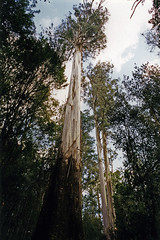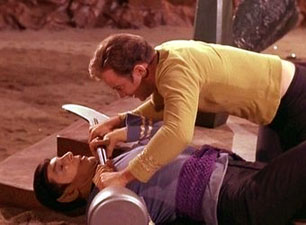 “Amok Time” is the first episode in airing sequence of season 2 of Star Trek. And, after the teaser, the first thing you notice is that the opening credit sequence has changed, with a modified version of the theme song, new graphics, and the addition of DeForest Kelley to the names of William Shatner and Leonard Nimoy. I was excited to watch this episode again, because it’s one of the true classics of the series – in fact I’d say it rivals “The City on the Edge of Forever“. It gives us our first truly deep look at Spock’s background and his home planet and culture, which turns out to be fascinating and surprising.
“Amok Time” is the first episode in airing sequence of season 2 of Star Trek. And, after the teaser, the first thing you notice is that the opening credit sequence has changed, with a modified version of the theme song, new graphics, and the addition of DeForest Kelley to the names of William Shatner and Leonard Nimoy. I was excited to watch this episode again, because it’s one of the true classics of the series – in fact I’d say it rivals “The City on the Edge of Forever“. It gives us our first truly deep look at Spock’s background and his home planet and culture, which turns out to be fascinating and surprising.
The teaser begins with a shot of Kirk climbing up a ladder out of a random tube and then out on to a deck, where he meets McCoy. Presumably the lift wasn’t working or something. McCoy is worried about Spock not eating, and Nurse Chapel then passes them with a bowl of Vulcan soup in an effort to get Spock to eat and notice her feminine charms. Spock tosses the soup and yells at Chapel, who leaves in tears. Spock then requests shore leave on his home planet, saying they could drop him off before the Enterprise‘s scheduled rendezvous at Altair VI “with a loss of only 2.8 light days”. I wonder how many light days it takes to do the Kessel run.
With such a reasonable delay, Kirk orders the ship on course for Vulcan. We see new crewman Ensign Chekov for the first time, in the role of navigator next to Sulu’s helm station. Throughout this episode they play a comical duet off one another which almost approaches a Greek chorus, commenting on the greater workings of the plot around them. Starfleet orders the Enterprise to make haste to Altair, where the ship is needed for a grand political display, so Kirk changes course again. Kirk then decides whatever is bugging Spock is clearly important, and orders Chekov to change course again and go to maximum speed, which puzzles Chekov because he says Spock has already ordered the course change.
Kirk confronts Spock about this; Spock does not deny it, but says he was not aware of having given such an order and says it’s possible. Kirk orders the ship back to Altair and Spock to sickbay for a medical. McCoy concludes that Spock is dying and needs to get to Vulcan within a week. Kirk confronts Spock and demands he tell him what’s going on. Spock reluctantly says it’s a matter of “biology” and, as embarrassed as a Vulcan can be, explains that Vulcans must return periodically to mate, as a biological imperative. Kirk treats this in strict confidence and tries to argue with Starfleet that he be excused from Altair to go to Vulcan – but the admiral won’t hear it and orders him directly to Altair. Kirk, naturally, ignores this order and tells Chekov to set course for Vulcan.
This conversation takes place in an interesting set, in part of sickbay, with McCoy present – perhaps his office. The good doctor seems to have an interesting collection of anthropoid skulls decorating several shelves of the room. Nurse Chapel overhears the conversation and goes to tell Spock the good news, by breaking into his private quarters while he’s asleep – apparently they don’t have security of any sort of crew quarters (or Chapel is a good lock-picker). There is a romantic tension moment as Spock thanks Nurse “my name is Christine” Chapel, and asks for a bowl of that soup.
Poor Christine is about to get her heart handed back to her, however, as they approach Vulcan and receive a message from a beautiful woman, who says she will meet Spock at the arranged place. Chapel asks who she is, Spock replies, “She is T’Pring, my wife.” For anyone who has watched the series to now, this is an eye-opening moment of shock, and the first indication that Spock has any sort of family connections at all. Spock explains there is a small ceremony and he would like Kirk and McCoy, as his friends, to stand with him. McCoy is genuinely flattered in a rare moment of camaraderie in what is usually a jokingly antagonistic relationship between him and Spock.
The three beam down and we get our first look at Vulcan. It looks hot. The sky is red – not pink like Mars, but red. The rocks are red, the sand is red (and also sparkly). Kirk and McCoy start sweating and McCoy quips that now he finally understand what is meant by the cliché “hot as Vulcan”. It’s good to see a planet that is so starkly different from the Earth-like planets they normally visit. They enter a ceremonial arena and Spock strikes a small gong, which summons a ceremonial party. T’Pring is there, with various escorts, and carried in on a sedan chair is T’Pau, a stately old woman who Kirk recognises as the only person ever to turn down a seat on the Federation Council.
The ceremony begins, with Spock walking up to strike the gong again, but T’Pring interrupts and shouts, “Kal-if-fee!” Spock lapses into a trance-like state. Kirk and McCoy are confused, but soon learn that T’Pring has invoked an ancient right, whereby she chooses a champion to fight for her hand against Spock. There is an obvious candidate in the wedding party with his eyes on T’Pring, one Stonn, but T’Pring passes him by and chooses Kirk, causing much uproar. (Her choice though is later explained and is flawlessly logical.) Kirk and McCoy confer, and Kirk explains that Spock looks weakened and would probably lose badly to Stonn, so Kirk will fight and try to knock him out without hurting him, or if Spock gets the upper hand he can resign and Spock can retain his honour. Kirk accepts the challenge.
T’Pau instructs that lirpa be brought forth. Spock and Kirk are handed incredibly vicious looking weapons, with huge curved blades at the end of a staff-like pole, weighted at the other end by a heavy metal cudgel. T’Pau then utters the best line of the episode: “If both survive the lirpa, combat will continue with the ahn-woon.” Kirk and McCoy aghast. The fight is to the death!
I’ll stop there so as not to spoil the ending, just go find a copy and watch it if you haven’t seen it before. It’s a terrific episode. There are disturbing messages about women as property, if you ignore the contexts both of when this was made and the fact that it’s depicting an alien society which is meant to be strangely different to human society – but in the context of the episode it makes sense. That can be forgiven on those grounds. And once over that hurdle, there’s nothing not to love about this episode. A strong character-driven plot, revealed character back-story, high drama, and beautiful comic relief from the new regular character who we will grow to love over the next two seasons. Man, why couldn’t there have been more like this, and fewer like… well, some of the lousy ones they made.
Tropes: Forgets To Eat, Not So Stoic, Those Two Guys, Greek Chorus, A Friend In Need, The Talk, Mate Or Die, Conflicting Loyalty, Screw The Rules, I’m Doing What’s Right, Unresolved Sexual Tension, Wham Line, Apron Matron, Grande Dame, Emotionless Girl, Double Weapon, Involuntary Battle To The Death (this episode provides the TV Tropes page image for this trope), Dutch Angle, Wanting Is Better Than Having, Fake Gunshot, Faking The Dead.
Body count: None.
(Image © 1967 Paramount Studios, used under Fair Use.)
 Yesterday I went for an overnight trip into the country with the wife. We stayed overnight at Kangaroo Valley, about 2.5 hours drive from Sydney. It’s doable in a day trip, but we figured we have some time off over the Christmas/New Year period so why not stay overnight and give ourselves time to explore at leisure, rather than rush. We drove down via Bowral and the Southern Highlands wine region, though we didn’t stop in at any wineries along the way. The weather was hot and we spent most of our activity time wandering around Bowral itself, then taking a walk through the bush at Fitzroy Falls to see this 82 metre waterfall plunging off the sandstone escarpment into the rainforest valley below.
Yesterday I went for an overnight trip into the country with the wife. We stayed overnight at Kangaroo Valley, about 2.5 hours drive from Sydney. It’s doable in a day trip, but we figured we have some time off over the Christmas/New Year period so why not stay overnight and give ourselves time to explore at leisure, rather than rush. We drove down via Bowral and the Southern Highlands wine region, though we didn’t stop in at any wineries along the way. The weather was hot and we spent most of our activity time wandering around Bowral itself, then taking a walk through the bush at Fitzroy Falls to see this 82 metre waterfall plunging off the sandstone escarpment into the rainforest valley below.
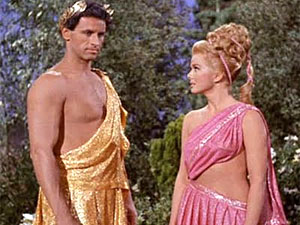 And so to episode 2 of the second season, “
And so to episode 2 of the second season, “ “
“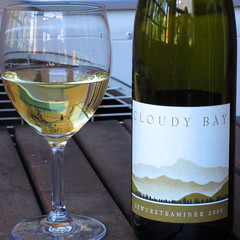
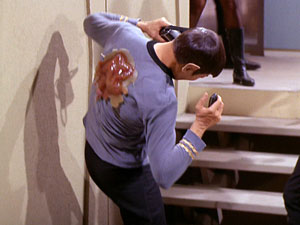 “
“